Last month the Australian labour market went backwards. That trend is now consolidating and the…
US labour market recovery is stop-start and precarious
Last Friday (February 5, 2021), the US Bureau of Labor Statistics (BLS) released their latest labour market data – Employment Situation Summary – February 2021 – which is consistent with a view that the US labour market recovery is stop-start at present and not reducing the jobs lost since March 2020 at any reasonable rate. prediction. Payroll employment growth was stronger in February. The labour force survey data showed consistent employment growth but not strong enough to really do anything about unemployment and the broader labour wastage captured by the BLS U6 measure which was constant at 11.1 per cent. Participation was steady in February, which when coming off a recession is a sign that employment growth is subdued. I remain wedded to the view that the US will have to stabilise the health situation before they will be able to sustain any reasonable economic recovery. Whether the vaccination process in train allows for that is an unknown at present. But with states like Texas seemingly in denial with respect tot the virus, I suspect bad outcomes will emerge in the month ahead. And with the Blue Democrats trying to be Republicans (denying a reasonable stimulus) that doesn’t augur well.
Overview for February 2021:
- Payroll employment increased by 379,000.
- Total labour force survey employment rose by 208 thousand net (0.14 per cent).
- The seasonally adjusted labour force rose by 50 thousand (0.03 per cent).
- Official unemployment fell by 158 thousand to 9,972 thousand.
- The official unemployment rate fell by 0.1 points to 6.2 per cent.
- The participation rate was unchanged at 61.4 per cent.
- The broad labour underutilisation measure (U6) was unchanged at 11.1 per cent but the part-time for economic reasons cohort (the US indicator of underemployment) rose by 134 thousand (2.3 per cent).
For those who are confused about the difference between the payroll (establishment) data and the household survey data you should read this blog post – US labour market is in a deplorable state – where I explain the differences in detail.
BLS explanation of COVID effects on data
The BLS say:
As in previous months, some workers affected by the pandemic who should have been classified as unemployed on temporary layoff were instead misclassified as employed but not at work. However, the share of responses that may have been misclassified was highest in the early months of the pandemic and has been considerably lower in recent months. Since March 2020, BLS has published an estimate of what the unemployment rate might have been had misclassified workers been included among the unemployed. Repeating this same approach, the seasonally adjusted February unemployment rate would have been 0.5 percentage point higher than reported. However, this represents the upper bound of our estimate of misclassification and probably overstates the size of the misclassification error.
So we are now operating in an environment of minimal uncertainty.
Payroll employment trends
The BLS noted that:
Total nonfarm payroll employment increased by 379,000 in February but is down by 9.5 million, or 6.2 percent, from its pre-pandemic level in February 2020. In February o this year, most of the job gains occurred in leisure and hospitality, with smaller gains in temporary help services, health care and social assistance, retail trade, and manufacturing. Employment declined in state and local government education, construction, and mining …
In February, employment in leisure and hospitality increased by 355,000, as pandemic-related restrictions eased in some parts of the country … Employment in leisure and hospitality is down over the year by 3.5 million, or 20.4 percent …
Within professional and business services, temporary help services added 53,000 jobs in February but is down by 175,000 from a year ago …
Employment in health care and social assistance increased by 46,000 in February … Employment in health care and social assistance is down by 909,000 over the year …
Retail trade added 41,000 jobs in February … retail trade has added 2.0 million jobs from May through February …
Manufacturing employment increased by 21,000 over the month, led by a gain in transportation equipment (+10,000). Employment in manufacturing is down by 561,000 over the year …
In February, employment declined in local government education (-37,000) and state government education (-32,000) …
Employment in construction fell by 61,000 in February … Employment in the industry is 308,000 below its level a year earlier.
We thus see the pattern repeating. The ‘contact’ sectors shed jobs in large numbers as lockdown restrictions tighten and then the restirctions are eased and these sectors add jobs. But unless they achieve widespread vaccination coverage the virus infection rates will grow again and the restrictions will have to return.
The first graph shows the monthly change in payroll employment (in thousands, expressed as a 3-month moving average to take out the monthly noise). The gray lines are the annual averages.
The data swings are still large and dwarf the past history.
Clearly, the 379,000 jobs gain (net) in February is a boost and an improvement.
But the US labour market is still 9.475 million jobs short from where it was at the end of February 2020.
The next graph shows the same data in a different way – in this case the graph shows the average net monthly change in payroll employment (actual) for the calendar years from 2005 to 2020 (the 2020 average is for the months to date).
The final average for 2019 was 168 thousand.
The final average for 2020 was -785 thousand.
The average for 2021 (so far) is 273 thousand.
Labour Force Survey – employment growth positive
The data for December reveals:
1. Employment as measured by the household survey rose by 208 thousand net (0.14 per cent).
2. The labour force rose by 50 thousand (0.03 per cent).
3. The participation rate was unchanged at 61.4 per cent.
4. As a result (in accounting terms), total measured unemployment fell by 158 thousand to 9,972 thousand and the unemployment rate fell 0.1 points to 6.2 per cent.
The BLS note that both unemployment measures:
… are much lower than their April 2020 highs, they remain well above their pre-pandemic levels in February 2020 (3.5 percent and 5.7 million, respectively).
The following graph shows the monthly employment growth since January 2008, which shows the massive disruption this sickness has caused.
To put the recent period in perspective I took out the extreme observations (outliers) between March 2020 and October 2020 and repeated the graph.
This graph shows how modest the current recovery is.
The Employment-Population ratio is a good measure of the strength of the labour market because the movements are relatively unambiguous because the denominator population is not particularly sensitive to the cycle (unlike the labour force).
The following graph shows the US Employment-Population from January 1950 to February 2021.
While the ratio fluctuates a little, the April 2020 ratio fell by 8.7 points to 51.3 per cent, which is the largest monthly fall since the sample began in January 1948.
In February 2021, the ratio rose by 0.1 points to 57.6 per cent.
It is still well down on the level in January 2020 (61.1 per cent).
As a matter of history, the following graph shows employment indexes for the US (from US Bureau of Labor Statistics data) for the five NBER recessions since the mid-1970s and the current 2020-COVID crisis.
They are indexed at the employment peak in each case and we trace the data out for each episode until one month before the next peak.
So you get an idea of:
1. The amplitude (depth) of each cycle in employment terms.
2. The length of the cycle in months from peak-trough-peak.
The early 1980s recession was in two parts – a short downturn in 1981, which was followed by a second major downturn 12 months later in July 1982 which then endured.
Other facts:
1. Return to peak for the GFC was after 78 months.
2. The previous recessions have returned to the 100 index value after around 30 to 34 months.
3. Even at the end of the GFC cycle (146 months), total employment in the US had still only risen by 8.3 per cent (since December 2007), which is a very moderate growth path as is shown in the graph.
The current collapse is something else and progress has now somewhat stalled.
Unemployment and underutilisation trends
The BLS report that:
Both the unemployment rate, at 6.2 percent, and the number of unemployed persons, at 10.0 million, changed little in February. Although both measures are much lower than their April 2020 highs, they remain well above their pre-pandemic levels in February 2020 (3.5 percent and 5.7 million, respectively).
The first graph shows the official unemployment rate since January 1994.
The official unemployment rate is a narrow measure of labour wastage, which means that a strict comparison with the 1960s, for example, in terms of how tight the labour market, has to take into account broader measures of labour underutilisation.
The next graph shows the BLS measure U6, which is defined as:
Total unemployed, plus all marginally attached workers plus total employed part time for economic reasons, as a percent of all civilian labor force plus all marginally attached workers.
It is thus the broadest quantitative measure of labour underutilisation that the BLS publish.
In December 2006, before the effects of the slowdown started to impact upon the labour market, the measure was estimated to be 7.9 per cent.
In February 2021 the U6 measure was unchanged at 11.1 per cent but the part-time for economic reasons cohort (the US indicator of underemployment) rose by 134 thousand (2.3 per cent).
The BLS say that:
The number of persons employed part time for economic reasons, at 6.1 million, changed little in February but is up by 1.7 million over the year. These individuals, who would have preferred full-time employment, were working part time because their hours had been reduced or they were unable to find full-time jobs …
In February, the number of persons not in the labor force who currently want a job was 6.9 million, little changed over the month but up by 1.9 million over the year. These individuals were not counted as unemployed because they were not actively looking for work during the last 4 weeks or were unavailable to take a job …
Among those not in the labor force who currently want a job, the number of persons marginally attached to the labor force, at 1.9 million, was essentially unchanged in February but is up by 453,000 over the year. These individuals wanted and were available for work and had looked for a job sometime in the prior 12 months but had not looked for work in the 4 weeks preceding the survey. The number of discouraged workers, a subset of the marginally attached who believed that no jobs were available for them, was 522,000 in February, little changed from the previous month but up by 121,000 over the year.
Ethnicity and Education
The next graph shows the evolution of unemployment rates for three cohorts based on educational attainment: (a) those with less than high school completion; (b) high school graduates; and (c) university graduates.
As usual, when there is a crisis, the least educated suffer disproportionately.
In the collapse in employment, the unemployment rates rose by:
- 14.4 points for those with less than high-school diploma.
- 12.9 points for high school, no college graduates.
- 5.9 points for those with university degrees.
The period since April 2020 has seen the unemployment rate fall by:
- 10.9 points for those with less than high-school diploma meaning the unemployment rate is now 3.8 points above the March level.
- 10.1 points for high school, no college graduates meaning the unemployment rate is now 4.6 points above the March level.
- 4.6 points for those with university degrees meaning the unemployment rate is now 2.3 points above the March level.
In the last month, the change in the unemployment rate has been:
- rise of 1 point for those with less than high-school diploma – so this cohort is bearing the cost of the stalled recovery.
- rise of 0.1 points for high school, no college graduates.
- fall of 0.2 points for those with university degrees.
In the US context, especially in the current time, the trends in trends in unemployment by ethnicity are interesting.
Two questions arise:
1. How have the Black and African American and White unemployment rate fared in the post-GFC period?
2. How has the relationship between the Black and African American unemployment rate and the White unemployment rate changed since the GFC?
Summary:
1. All the series move together as economic activity cycles. The data also moves around a lot on a monthly basis.
2. The Black and African American unemployment rate was 6.8 per cent in March 2020, rose to 16.7 per cent in May and is now down to 9.9 per cent in February 2021. In the last month, it rose 0.7 points.
3. The Hispanic or Latino unemployment rate was 6 per cent in March 2020, rose to 18.9 per cent in April and fell to 8.5 per cent in February 2021. In the last month, it fell 0.1 points.
4. The White unemployment rate was 3.9 per cent in March 2020, rose to 14.1 per cent in April and fell to 5.6 per cent in February 2021. In the last month, it fell 0.1 points.
So the deterioration in the labour market in the last month has all been born by Black and African Americans with less than secondary education.
The next graph shows the Black and African American unemployment rate to White unemployment rate (ratio) from January 2018, when the White unemployment rate was at 3.5 per cent and the Black or African American rate was at 7.5 per cent.
This graph allows us to see whether the relative position of the two cohorts has changed since the crisis.
If it is rising, then the unemployment rate of the Black and African American cohort is either rising faster than the white unemployment rate or falling more slowly (or a combination of that relativity).
While there is month-to-month variability, the data shows that, in fact, through to mid-2019, the position of Black and African Americans had improved in relative terms (to Whites), although that just reflected the fact that the White unemployment was so low that employers were forced to take on other ‘less preferred’ workers if they wanted to maintain growth.
In April 2019, the ratio was 2.1 (meaning the Black and African American unemployment rate was more than 2 times the White rate).
By April 2020, the ratio had fallen to its lowest level of 1.2, reflecting the improved relative Black and African American position.
As the pandemic hit, the ratio rose and peaked at 1.8 in October 2020.
In February 2021, the ratio was 1.77 rising from 1.61 in January.
Conclusion
The February 2021 US BLS labour market data release reveals that the recovery seen since the catastrophic labour market collapse in March and April has somewhat stalled.
The US labour market is still 9.475 million jobs short from where it was at the end of February 2020.
And usually, after a recession, the bounceback in participation rates is a sign of healthy employment opportunities being generated.
The fact that participation was steady isn’t a good sign in this context.
I consider that the US will have to stabilise the health situation before they will be able to sustain any reasonable economic recovery.
The new US government also appears to have become hijacked by some Democrats who would be Republicans.
That is enough for today!
(c) Copyright 2021 William Mitchell. All Rights Reserved.
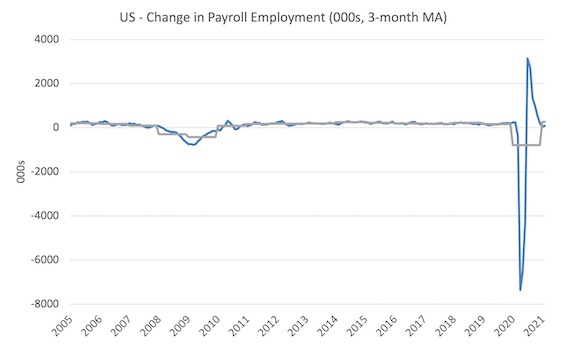

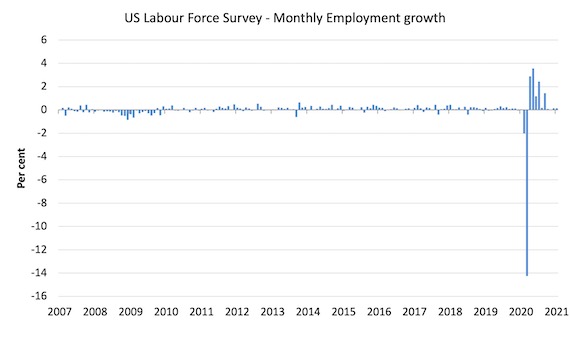
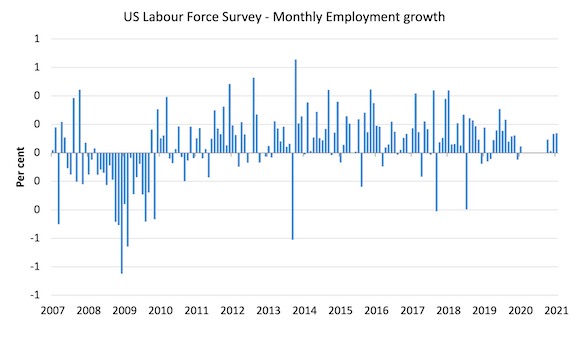
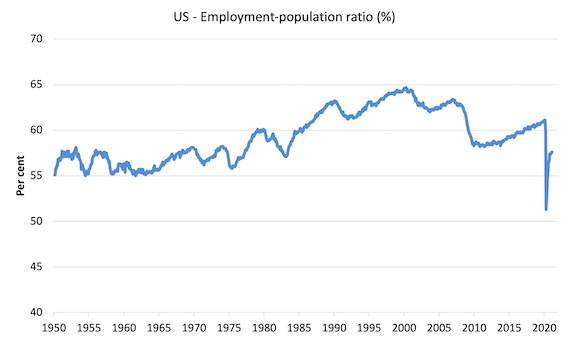
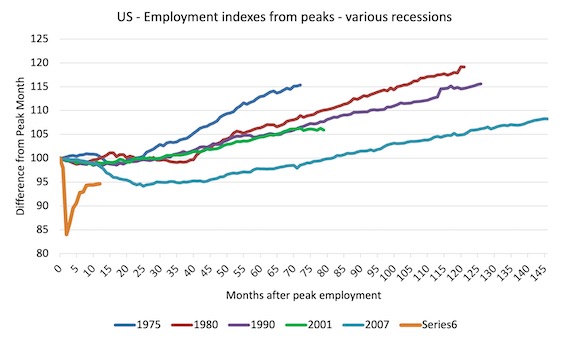
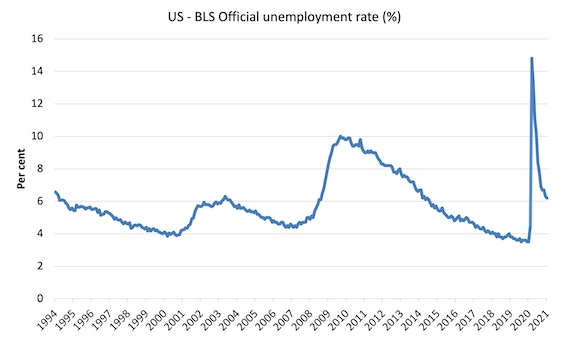
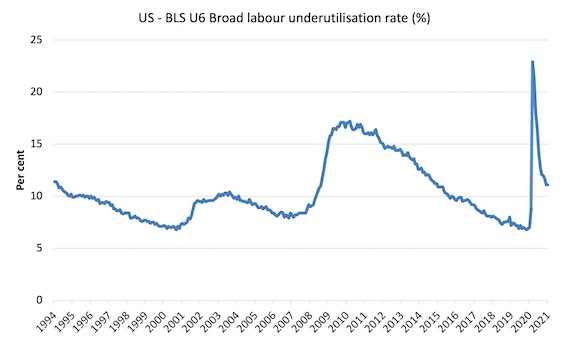
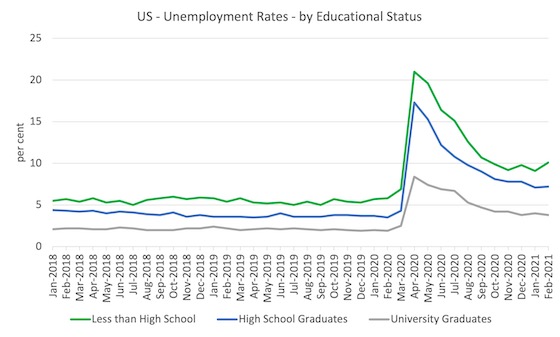
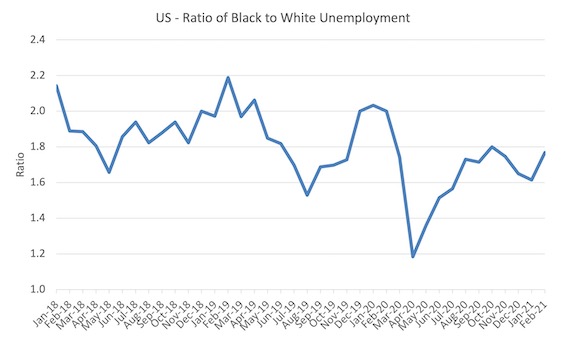
This Post Has 0 Comments